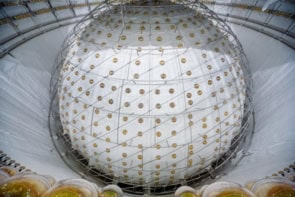The physicist and philosopher Carl Friedrich von Weizsäcker, who was the last surviving member of the team that tried and failed to build a nuclear bomb for Germany during the Second World War, died on 28 April at the age of 94. After the war, von Weizsäcker controversially claimed that he and other German physicists had deliberately chosen not to build the bomb because they did not want to equip the Nazi regime with such a dangerous weapon. Von Weizsäcker also accompanied Werner Heisenberg to visit Niels Bohr in Nazi-occupied Denmark in September 1941 -- a famous meeting that was later to inspire Michael Frayn's stage play Copenhagen.

Carl Friedrich von Weizsäcker was born on 28 June 1912 in the northern German port city of Kiel. Between 1929 and 1933 he studied physics, astronomy and maths in Berlin, Göttingen and Leipzig, where he worked with some of the leading physicists of his day, including Heisenberg, Bohr and Erwin Schrödinger. As a young physicist, von Weizsäcker became interested in the binding energy of atomic nuclei and in 1937 determined what later became known as the “Bethe–Weizsäcker formula”, which predicts the energy of the nucleus in terms of the number of constituent protons and neutrons.
In 1939 von Weizsäcker became part of Germany’s “uranium project” — a loose network of scientists across the country who began carrying out research into nuclear reactors, isotope separation and nuclear explosives. Although these scientists never succeeded in building a practical nuclear weapon, historians have long wondered why this was the case. Some have argued that physicists like Heisenberg and von Weizsäcker simply lacked the technical knowledge to build a bomb. Others claim that these physicists did not bother determining key quantities like the critical mass of the bomb because they knew the German government did not have the resources to ever build such a device, which made it pointless to carry out such a calculation.
After the war, von Weizsäcker claimed that the real reason why he and other German scientists had not built a bomb was that they had deliberately chosen not to, fearing its appalling consequences in the hands of the Nazi regime. Von Weizsäcker first put forward this version of events in interviews he gave with the historian Robert Jungk, whose 1957 book Brighter than a Thousand Suns suggested that von Weizsäcker and Heisenberg had acted honourably all along.
The full story only emerged years later when transcripts of conversations between von Weizsäcker, Heisenberg and eight other German physicists, who had been secretly recorded while they were interned by the British military at Farm Hall, near Cambridge, were finally published in 1993. It turned out that von Weizsäcker had deliberately encouraged his fellow physicists to argue that they had never wanted to build a bomb, even though they knew this was not strictly true.
After the war, von Weizsäcker returned to research, being appointed director of the department of theoretical physics at the Max Planck Institute in Göttingen before taking up a professorship at the University of Hamburg in 1957. That he year he was one of 18 prominent scientists to sign the “Göttingen declaration”, which called for West Germany to not develop nuclear weapons.
A committed Christian, von Weizsäcker also turned his attention to philosophy, developing a keen interest in ethics and responsibility. His books include The World View of Physics, The Unity of Nature and The Politics of Peril. Von Weizsäcker’s younger brother, Richard von Weizsäcker, was German president between 1984 and 1994.
Von Weizsäcker briefly returned to the spotlight in 2002 when he commented on the release of letters that Bohr had written — but never sent — concerning the visit of Heisenberg and Von Weizsäcker to Copenhagen in September 1941. These letters suggest that Heisenberg and colleagues had indeed been working flat-out on a bomb between 1939 and 1941.



